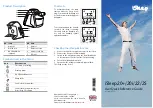
+1 (866) 381-2785
8
Double Loop
A double loop must be used when you are not establishing the boundary zone on all sides of your property.
When using a double loop, the boundary wire must be separated by a minimum of
5 ft.
to avoid
canceling the signal. Remember that a double loop will require twice as much wire.
Sample 3 (2F): Front or Back Yard Only (Double Loop)
From the fence transmitter, run the wire to A, A to B, B to C, C to D,
D to E, E to F, make a U-turn and follow your path all the way back to A,
keeping the wire separated at least 5 ft. Twist the wire from A back to the
fence transmitter.
Sample 4 (2G): Front Boundary Only (Double Loop)
From the fence transmitter, run the wire to A, A to B, B back to A keeping
the wire separated at least 5 ft Twist the wire from A back to the
fence transmitter.
Sample 5 (2H): Lake Access (Double Loop)
From the fence transmitter, run the wire to A, A to B, make a U-turn and go
to C, C to D, D to E, make a U-turn and follow your path all the way back to
A keeping wire separated at least 5 ft. Twist the wire from A back to the
fence transmitter.
Sample 6 (2J): Wire Loop Attached to Existing Fence (Double Loop)
This layout allows you to include your existing fence as part of your layout
and keep your pet from jumping out or digging under your existing fence. It
reduces the amount of wire which will need to be buried. Run the wire from
the fence transmitter to A, A to B, B to C, C to D, D to E, E to F, make a U-turn
and follow your path all the way back to A, keeping the wire separated at
least 5 ft. Twist the wire from A back to the fence transmitter. See the “Install
the Boundary Wire” section for more information on attaching the wire to
a fence.
Position the Boundary Wire
Lay out the boundary wire using your planned boundary and test the
system BEFORE burying the wire or attaching it to an existing fence. This
will make any layout changes easier. Work carefully. A nick in the wire
insulation can diminish the signal strength and create a weak area where
your pet can escape.
Running the boundary wire parallel to and within 10 ft. of electrical wires,
neighboring containment systems, telephone wires, television or antenna
cables, or satellite dishes may cause an inconsistent signal. If you must
cross any of these, do so at 90-degree angles (perpendicularly) (
3A
).
If separating your boundary wire by at least 10 ft. from a neighboring containment system’s wire does not
reduce the inconsistent signal, contact the Customer Care Center.
E
F
B
A
D
C
E
F
C
A
D
B
5 ft.
5 ft.
2F
B
A
5 ft.
2G
E
B
D
C
A
5 ft.
2H
E
F
B
A
D
C
5 ft.
2J
90°
Boundary
Wire
Buried Cable
10 ft.
10 ft.
3A









































